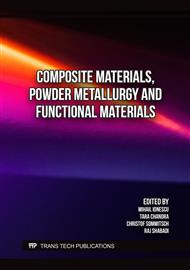p.15
p.21
p.27
p.33
p.49
p.55
p.61
p.67
p.73
A Unique Hall-Petch Relation of Harmonic Structure Designed Pure Ni
Abstract:
Harmonic structure has a heterogeneous microstructure consisting of bimodal grain size together with a controlled and specific topological 3D distribution of fine and coarse grains. These microstructural features of the harmonic structure materials lead to unique mechanical properties. In this study, harmonic structure was designed using the severe plastic deformation powder metallurgy process at room and cryogenic temperatures on pure nickel. There is no difference in appearance between mechanically milled (MM) powder at room and cryogenic temperatures. The compacts of the MM powder show the harmonic structure with a network fine grained area and the dispersed coarse grain area. The MM at cryogenic temperature affects the compact of the MM powder milled for 86.4 ks and its effects include an increase in shell fraction and a decrease in core grain size. Moreover, the harmonic structure materials show a synergy extra hardening in Hall-Petch relation. It is noteworthy that the harmonic structure materials exhibit a higher Hall-Petch coefficient than the homogeneous compacts despite of the same material.
Info:
Periodical:
Pages:
49-54
Citation:
Online since:
December 2023
Price:
Сopyright:
© 2023 Trans Tech Publications Ltd. All Rights Reserved
Share:
Citation:



